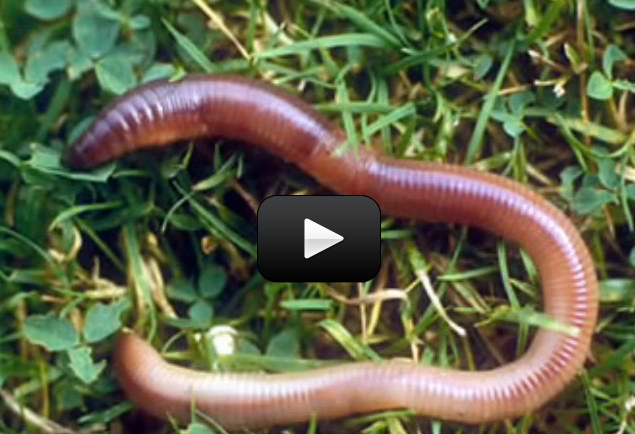Here we’re going to discuss the differences between three types of worms; flatworms, roundworms, and segmented worms. The word “worm” is not, in fact, a scientific name. It’s an informal way of classifying animals with long bodies and no appendages (no including snakes). They are bilaterally symmetrical (the right and left sides mirror each other). Worms live in salt and fresh water, on land, and inside other organisms as parasites.
The differences between the three types of worms we will discuss depend on the possession of a body cavity and segments. Flatworms have neither a body cavity nor segments. Roundworms only have a body cavity, and segmented worms have both a body cavity and segments.
Flatworms (Phylum Platyhelminthes) have incomplete digestive systems. That means that their digestive system has only one opening. The gas exchange occurs on the surface of their bodies. There are no blood vessels or nervous systems in flatworms. Some are non-parasitic, like the Sea flat worm, and some are parasitic, like the tapeworm.
[am4show have=’p8;p9;p11;p38;p92;p28;p55;p78;p86;p87;’ guest_error=’Guest error message’ user_error=’User error message’ ]
Roundworms (Phylum Nematoda) have body cavities—as contrasted with flatworms which do not. The body cavity allows roundworms to have complete digestive tracts (both a mouth and an anus). The mouth and anus are connected by a gut—where the food is digested. They also have a simple nervous system and brain.
Roundworms can be parasites of plants and animals. In dogs they are often know to cause heart problems. In humans roundworm parasites can sometimes cause a swelling disease called elephantitis.
Annelids or Segmented Worms (Phylum Annalida) the most developed of the three, have both a body cavity and segments. Their body cavity helps give them structure—it serves as a hydroskeleton. By “segmented” it’s meant that they are divided into repeating units. They can be non-parasitic (i.e. earthworms) or parasitic (i.e. leeches). Interestingly, the giant red leech only eats giant earthworms.
Worm Column
If you’re fascinated by worms but frustrated that you can’t see them do their work underground, then this worm column is just the ticket for you. By using scrap materials from the recycling bin, you’ll be able to create a transparent worm farm. here’s what you need:
- two 2-liter soda bottles, empty and clean
- one brown paper grocery bag
- 20 red worms
- newspaper, old leaves, peat moss, and/or straw for worm bedding
- last night’s dinner, organic scraps, plant material for worm food
Here’s what you do:
Download Student Worksheet & Exercises
Things to Compare with your Worms:
- Look at the worms under the magnifying glass.
- Measure the lengths of the worms.
- Make note of:
- The outer layer of the worms: Is it hard? Is it segmented? What are other observations that can be made?
- Do they have legs?
- Do they have antenna?
- What are the main differences?
- What are the main similarities?
Garden Worm Tower
Here’s how you can make your own worm tower right in your garden:
Build your own worm farm and watch them turn food scraps into soil!
Materials:
- 2 polystyrene boxes with lids the same size. (Let’s call them Bin A and Bin B.)
- A sheet of insect screen to fit the bottom of the boxes
- Newspaper clippings
- Garden soil
- Food scraps (half-eaten fruits and veggies, stale biscuits and cakes, crushed egg shells, coffee grounds)
- Water
- Worms (Either “Tiger”, “reds”, or “blues”; ask for them at your local garden store)
Build the farm:
- Punch evenly spaced holes in the bottom of Bin A.
- Place the insect screen on the bottom of Bin A (this is so that the worms don’t fall out).
- Fill Bin A ¾ full with wet newspaper clippings.
- Add a layer of garden soil to Bin A.
- Add the worms.
- Place Bin A in Bin B. Make sure there’s enough room in Bin B when Bin A’s placed in it to collect the worm pee and waste. Be sure to empty and clean Bin B every couple days.
- Add food to bin A! Start off small. You don’t want to over-feed the worms. Start out with a couple scraps in the corner and see how long it takes for them to disappear—that should give you a good idea of how much to feed your worms.
Earthworm Dissection
You can dissect a earthworm right at home using this inexpensive earthworm specimen and simple dissection tools!
Exercises
- What are three types of worms?
- What are the characteristics of each?
- What are the elements of a complete digestive system?
- What are some benefits of worms in gardening?
[/am4show]


Yes, use what you have. My worm farm has nightcrawlers.
Can I use earthworms instead of red worms?